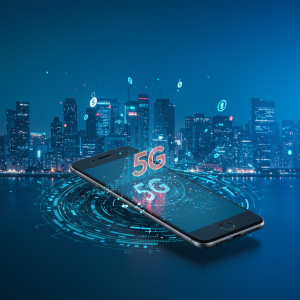How Mobile Commerce Works: A Guide to the Mobile Shopping Revolution

Mobile trading-on M-summit has been briefly transformed as how the consumer interacts with businesses and how our rapid transactions occur in the digital world. When the smartphone becomes an extension of itself, the facility has to shop at any time and anywhere tickled mobile trade for an essential business strategy from a new concept. Today, more than 70% of all e-commerce traffic comes from mobile devices, highlighting its dominance in the retail scenario.
The Rise of Mobile Commerce in the Digital Economy
The development of mobile trade represents one of the most important changes in consumer behavior in recent decades. From simple SMS-based shopping systems in the early 2000s, from the refined AI-controlled shopping application, the Mobile Commerce system has increased rapidly both. This broad guide explains how mobile trade really works, and breaks its technical infrastructure, security mechanisms, business models and future track.
What Exactly Is Mobile Commerce?
Mobile trading includes all commercial transactions performed through mobile devices including smartphones and tablets. Unlike traditional e-commerce, which mainly focuses on desktop-based transactions, M-commerce uses the unique properties of mobile technology-which includes location awareness, fast connection and individual user experiences to create a-to create a journey.
The scope of mobile commerce extends far beyond retail shopping to include:
- Mobile banking and financial services
- Digital content purchases (apps, music, videos, e-books)
- Mobile ticketing for events and transportation
- Contactless payments at physical stores
- Food ordering and delivery services
- Peer-to-peer money transfers
- In-app purchases within mobile applications
- Subscription-based services
The true power of mobile commerce lies in its ability to blur the lines between physical and digital shopping experiences, creating omnichannel journeys that meet consumers exactly where they are.
The Technical Infrastructure Behind Mobile Commerce
Mobile Devices and Operating Systems
The foundation of mobile commerce begins with the devices themselves. Modern smartphones feature powerful processors, high-resolution displays, and various sensors that enable rich commercial experiences. The dominant mobile operating systems—iOS and Android—provide the platform infrastructure that supports mobile commerce applications through:
- App stores that facilitate the discovery and distribution of shopping applications
- Payment APIs that allow secure transaction processing
- Push notification systems for marketing communications
- Location services for geotargeted offers and experiences
Mobile Applications vs. Progressive Web Apps
Mobile commerce operates through two primary channels:
1. Native Mobile Applications: These purpose-built apps are downloaded from app stores and installed directly on users’ devices. They offer advantages like:
- Offline functionality
- Device hardware integration (camera, GPS, fingerprint sensors)
- Push notifications
- Faster performance
- Brand presence on the user’s home screen
2. Progressive Web Apps (PWAs): These browser-based applications combine the best elements of websites and native apps, featuring:
- No installation requirement
- Cross-platform compatibility
- Reduced development costs
- Easier updates and maintenance
- Improved visibility in search engines
According to recent Statista research, consumers spend approximately 90% of their mobile time using apps rather than browsers, explaining why major retailers invest heavily in native application development despite the higher costs.
Payment Processing Infrastructure
The payment processing backbone of mobile commerce involves multiple interconnected systems:
- Payment Gateways: These services authorize credit card transactions between merchants and payment processors.
- Digital Wallets: Services like Apple Pay, Google Pay, and PayPal store payment information securely and facilitate quick checkout experiences.
- Banking Networks: These process the actual movement of funds between accounts.
- Tokenization Systems: Security mechanisms that replace sensitive payment data with unique identifiers.
When a consumer makes a purchase, their payment information travels through this ecosystem in milliseconds, with multiple security checks occurring along the way.
The Mobile Commerce Customer Journey
Understanding how mobile commerce works requires examining the typical customer journey, which often includes:
Discovery Phase
Mobile shoppers discover products through multiple channels:
- Social media platforms with integrated shopping features
- Mobile search engines
- Push notifications from installed apps
- QR codes scanned in physical locations
- Email marketing campaigns
- In-app advertisements
Consideration and Research
During this phase, consumers typically:
- Read product reviews and ratings
- Compare prices across different retailers
- View product demonstration videos
- Check product availability
- Save items to wishlists for later consideration
Mobile commerce platforms optimize this phase by providing rich product information within a constrained screen size, often utilizing innovative UI patterns like swipeable galleries, expandable information sections, and augmented reality features that allow shoppers to visualize products in their own environment.
Transaction Process
The actual purchase flow in mobile commerce has been progressively streamlined to minimize friction:
- Cart Building: Users select products and add them to a virtual shopping cart.
- Checkout Initiation: When ready to purchase, users proceed to checkout.
- Authentication: Users verify their identity through passwords, biometrics (fingerprint/facial recognition), or one-time passcodes.
- Payment Selection: Users choose their preferred payment method from saved options or enter new payment details.
- Purchase Confirmation: Following successful payment processing, users receive order confirmation.
The most sophisticated mobile commerce platforms can reduce this entire process to just a few taps through technologies like one-click ordering and biometric payment authorization.
Post-Purchase Experience
Mobile commerce extends beyond the transaction to include:
- Order tracking through push notifications
- Digital receipt management
- Product setup and usage guidance
- Review solicitation
- Cross-selling of complementary products
- Loyalty program integration
Security Mechanisms in Mobile Commerce
Security forms the cornerstone of mobile commerce operations, with multiple layers of protection:
Device-Level Security
- Biometric authentication (fingerprint and facial recognition)
- Device encryption
- Remote wipe capabilities for lost devices
- Secure enclaves for storing sensitive payment information
Application Security
- Certificate pinning to prevent man-in-the-middle attacks
- Jailbreak/root detection
- Runtime application self-protection (RASP)
- Regular security updates and patches
Transaction Security
- End-to-end encryption of payment data
- Tokenization of credit card information
- 3D Secure protocols for additional authentication
- Fraud detection algorithms that analyze transaction patterns
According to cybersecurity experts at Norton, modern mobile commerce platforms implement up to 12 distinct security layers to protect consumer data and transaction integrity.
Business Models in the Mobile Commerce Ecosystem
Various business models have emerged within the mobile commerce landscape:
Direct Retail
Brands and retailers sell products directly to consumers through their mobile applications or websites. Examples include Amazon, Walmart, and most traditional retailers with mobile presences.
Marketplaces
Platforms that connect multiple sellers with consumers, typically taking a commission on sales. Examples include eBay, Etsy, and various food delivery marketplaces.
Subscription Services
Recurring revenue models for digital content, physical products, or services. Examples include Netflix, Spotify, and various subscription box services.
Freemium Applications
Free apps with premium features available for purchase. Common in gaming and productivity applications.
Advertising-Supported
Free commercial services that generate revenue through targeted advertising based on user behavior.
Emerging Technologies Reshaping Mobile Commerce
Several technologies are actively transforming how mobile commerce works:
Augmented Reality (AR)
AR allows shoppers to visualize products in their own environment before purchasing. Furniture retailers like IKEA and cosmetics brands like Sephora have pioneered this technology, enabling virtual “try-before-you-buy” experiences that significantly reduce return rates.
Voice Commerce
Voice assistants like Amazon’s Alexa, Google Assistant, and Apple’s Siri are creating new touchpoints for mobile commerce, allowing consumers to make purchases through voice commands alone.
Artificial Intelligence and Machine Learning
AI powers numerous mobile commerce functions:
- Personalized product recommendations
- Visual search capabilities
- Chatbots for customer service
- Dynamic pricing optimization
- Fraud detection systems
5G Connectivity
The rollout of 5G networks is dramatically improving mobile commerce experiences through:
- Faster page loading times
- Higher-quality product imagery and video
- More responsive augmented reality features
- Enhanced real-time inventory visibility
- Smoother checkout processes
Challenges in the Mobile Commerce Landscape
Despite its growth, mobile commerce faces several persistent challenges:
User Experience Limitations
Small screen sizes and variable network conditions can create friction in the shopping experience. Businesses continue to innovate with adaptive layouts, optimized images, and offline capabilities to overcome these limitations.
Cross-Device Continuity
Consumers often begin shopping journeys on one device and complete them on another. Sophisticated mobile commerce systems must maintain session continuity and synchronized shopping carts across devices.
Privacy Concerns
The personalization that makes mobile commerce effective relies on extensive data collection, raising privacy concerns among consumers. The industry continues to navigate the balance between personalization and privacy protection.
International Complexity
Global mobile commerce operations must navigate different payment methods, currencies, languages, shipping restrictions, and regulatory environments.
The Future of Mobile Commerce
The mobile commerce landscape continues to evolve rapidly, with several key trends emerging:
Social Commerce Integration
Social media platforms are increasingly incorporating native shopping experiences, allowing users to purchase products without leaving their social apps. This convergence of social media and commerce represents one of the fastest-growing segments in mobile commerce.
Hyper-Personalization
Advanced data analytics and AI are enabling unprecedented levels of personalization, with some platforms now capable of predicting consumer needs before the consumers themselves articulate them.
Contactless Everything
The pandemic accelerated adoption of contactless technologies, from payments to curbside pickup options. This trend continues to expand across the mobile commerce ecosystem.
Mobile Commerce as the New Default
As we move deeply in the 2020s, mobile trading is no longer the possibility of traditional e-commerce-it has become a primary commercial channel for many companies and consumers. Understanding how mobile trade works to ensure that all sizes of companies remain competitive in digital marketplace.
The brands that bloom in this environment are those who see the mobile not only as another sales channel, but also as a comprehensive platform for customer commitment throughout the shopping trip. By optimizing each step of the mobile trade experience – from purchases and beyond the purchases can create spontaneous experiences that meet the expectations of modern consumers for simplicity, privatization and security.






